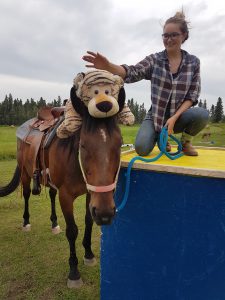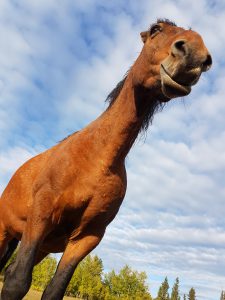Your horse might sometimes be calm and relaxed with you…and at other times he seems distracted or frightened.
How about this for an example: When he’s at home in his pasture with his buddies he’s content when you’re with him. But you haul him off to a clinic and now he’s a nervous wreck.
Why is this? The answer is that your horse is sometimes finding peace in your presence but not finding peace in your leadership.
Let’s examine this in detail. Three categories of pressure can affect your horse. These are herd pressure, physical pressure and predator pressure. When he is free of those pressures he stands calm with a relaxed head and soft eyes. He might lie down in the grass and go to sleep. He might also enjoy your company. The peace your horse is experiencing might be happening when he’s with you, but not necessarily because of you. Your horse does not have to consider you a herd leader to hang out and enjoy your company.

Sometimes your leadership agreement with your horse can be lacking or unclear. “What? Not me!” you say. In truth, the vast majority of folks can use a little polishing of that leadership agreement. I even need to revisit that from time to time with some of my horses as they grow up or herd dynamics change. The major factor is – and let’s face it – they’re generally with a different herd (their pasture buddies) for more than 90% of their lives. So we have to ensure our leadership agreement is functioning – and strong – when we take them from their pasture herd.
An Important Thought
I need to clear up a couple of misnomers. First, making or forcing your horse to do something does NOT grant us leadership status. Second, if we punish him for being ‘bad’, a ‘behavior issue’ or ‘not obeying’, this also does nothing in his eyes to establish leadership. We are simply teaching him that we are an unpredictable predator capable of causing him distress. We don’t want that. As a leader, we desire that our followers believe we can guide and support them, particularly when they’re struggling.
What then, is the leader of the herd (aka YOU) supposed to do? Well, it’s the job of the leader in the herd to decide what is safe and what is not, when to run from and when to ignore pressure, when to eat and when to sleep. If your horse does not believe this of you, there are typically some obvious signs. He walks ahead or behind you when being led. He’s fussy. He’ll turn left when you’re thinking turn right. When riding he might ‘do his own thing’ or ‘not want to do something’. He might even take off on you – whether you’re on his back or not. In more extreme cases a horse might bite or kick at you.
 Just to reemphasize: if any of the things I noted above are happening – your horse does NOT have a behavior issue. Humans use a variety of terms – ‘behavior issue’ is one of them – when personifying horses. We personify horses when we don’t understand why they are doing what they are doing and need to explain it somehow. We resort to explaining their actions as if they were humans – simply because it’s something we can relate to. Our horse’s behavior is completely correct, however. He is behaving exactly the way any horse would that is frightened, knows they are the leader of the herd or confused about/challenging leadership. If we’re not stepping into the leadership role in a very clear, understandable way for him, it’s natural for him to assume that position and take care of matters on his own. Again – he doesn’t have a behavior problem – we have a leadership issue. If you are a proven leader he will follow you and trust in your decisions of what is safe or what to be scared of.
Just to reemphasize: if any of the things I noted above are happening – your horse does NOT have a behavior issue. Humans use a variety of terms – ‘behavior issue’ is one of them – when personifying horses. We personify horses when we don’t understand why they are doing what they are doing and need to explain it somehow. We resort to explaining their actions as if they were humans – simply because it’s something we can relate to. Our horse’s behavior is completely correct, however. He is behaving exactly the way any horse would that is frightened, knows they are the leader of the herd or confused about/challenging leadership. If we’re not stepping into the leadership role in a very clear, understandable way for him, it’s natural for him to assume that position and take care of matters on his own. Again – he doesn’t have a behavior problem – we have a leadership issue. If you are a proven leader he will follow you and trust in your decisions of what is safe or what to be scared of.
Luckily this is an easy fix. We start each one of our clinics at Amazing Horse Country by ensuring all of our participants are the herd leader in their horse’s eyes. We do this by communicating clearly in their language – not through pain or punishment. In a few minutes, we see fear, fussy, pushy – all those unwanted things – disappear. Your horse will be super calm with a low head. He might even close his eyes and yawn. Why? Because by assuming the leadership role, you take the stresses off his plate. It’s now your job as the herd leader to manage those stresses.
It’s a great start. But it’s only just the beginning. Now you have to prove you deserve the position.
Trust on the Front Line
Trust is an easy word to throw around. Sure you can trust someone. But can you trust them always? Or only when things are going good? What is it that builds a trust that goes one step beyond? The answer is: experiences. It’s being in a sticky spot, a dangerous place, when someone who has committed to you has pulled you free of that. It’s when your relationship is put to the test and that person comes through for you over and over again.
Granted, these types of front line trust don’t happen every day. They’re special, deep and meaningful. We remember them. We tell stories about them. The most fantastic part of this: in our style of horse training, we create them.
This Front Line Trust is built by repetitive successful experiences – and it’s critical. It’s why we use the obstacle course extensively at Amazing Horse Country. First, you earn the herd leader position. Now you have to prove to your horse you qualify for that position. Through comprehensive and thorough work on the obstacles or trail course, your horse learns to trust you time and time again. This builds a deep and meaningful trust based on experience.
When your horse views you as the leader – you are now shouldered with the responsibility of deciding what is safe, when to run and when to relax. When you have shown time and again that your decisions result in his safety and success, you will earn Front Line Trust.
Here is the big difference. Your horse will seek you for answers on potentially ‘scary’ situations. And if your answer is “we don’t have to worry about this” – then he likely won’t. We regularly see fear change to curiosity on the obstacle course when this happens.
Conversely, if the horse does not have a solid belief that you are a trustworthy leader, then there is no reason to expect he’ll believe you when you are calm but he thinks he’s going to die. This is where your horse takes off on you or ‘refuses’ to do something. And he’s absolutely right to do that. He’s a prey animal that, unless he trusts in a higher authority, will do what he has to do to save himself. For a horse, any unknown is potentially fatal. It’s really common sense when we consider prey animal thinking and herd mentality.
 Peace in your leadership is demonstrated when the horse learns to trust your decisions in pressure situations. Not only is this vitally important, it’s easy to train for. In our clinics the first step is establishing leadership, the second is to develop that under pressure – every obstacle on the course is a pressure of some sort for the horse, so we use these to build his confidence. Not only confidence in himself but in you. You can take this new leadership agreement to whatever discipline you ride in or off to the mountains on a pack trip. For many folks this is a make-or-break deal for trail riding – they want a horse they can trust. When your horse truly defers to your leadership out of an established trust, what happens in a ‘scary’ situation is now your choice.
Peace in your leadership is demonstrated when the horse learns to trust your decisions in pressure situations. Not only is this vitally important, it’s easy to train for. In our clinics the first step is establishing leadership, the second is to develop that under pressure – every obstacle on the course is a pressure of some sort for the horse, so we use these to build his confidence. Not only confidence in himself but in you. You can take this new leadership agreement to whatever discipline you ride in or off to the mountains on a pack trip. For many folks this is a make-or-break deal for trail riding – they want a horse they can trust. When your horse truly defers to your leadership out of an established trust, what happens in a ‘scary’ situation is now your choice.
Just think about how big that is.
Scott Phillips – November 2017
